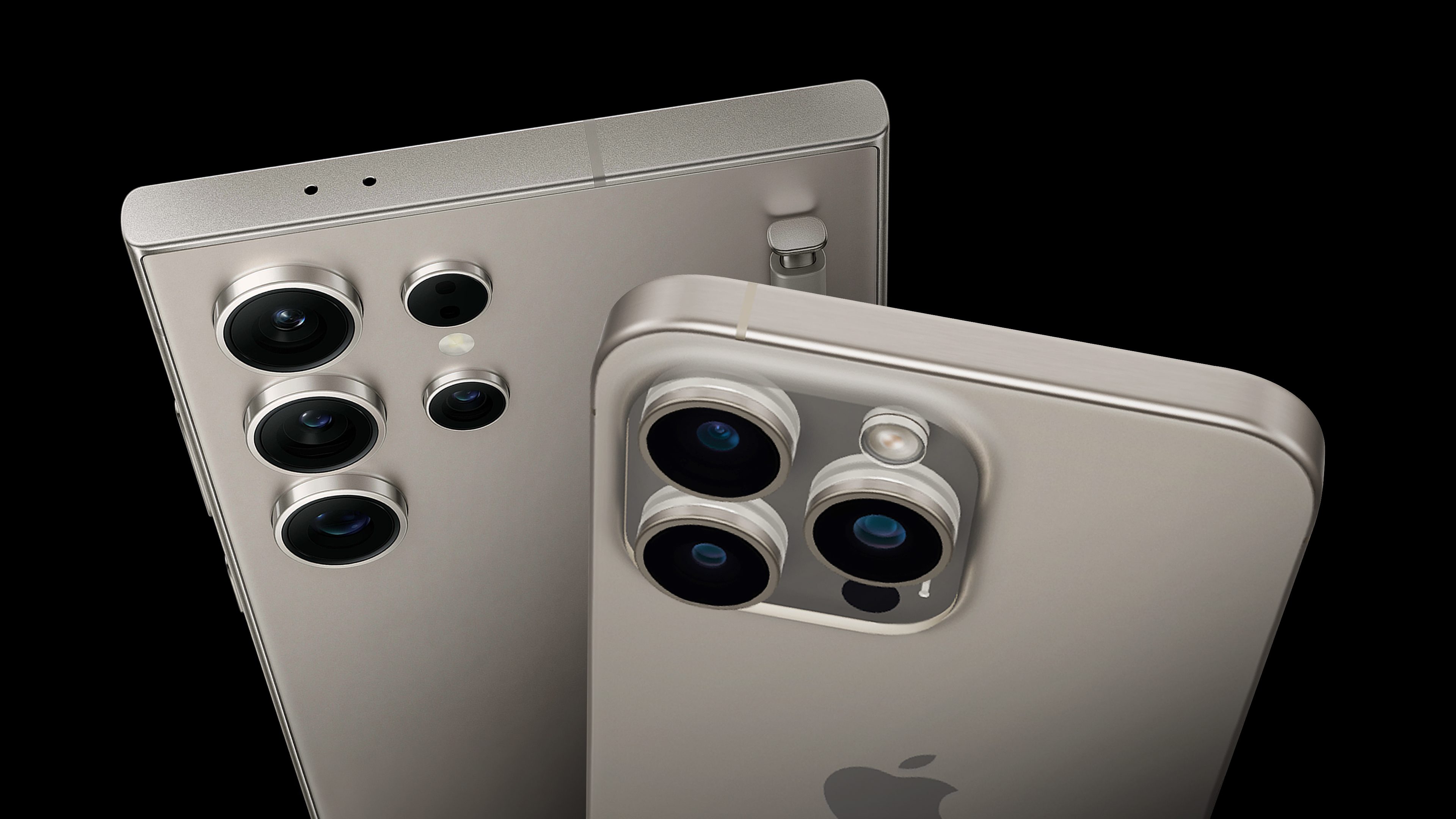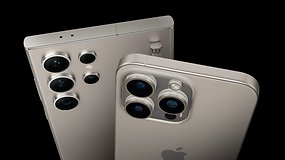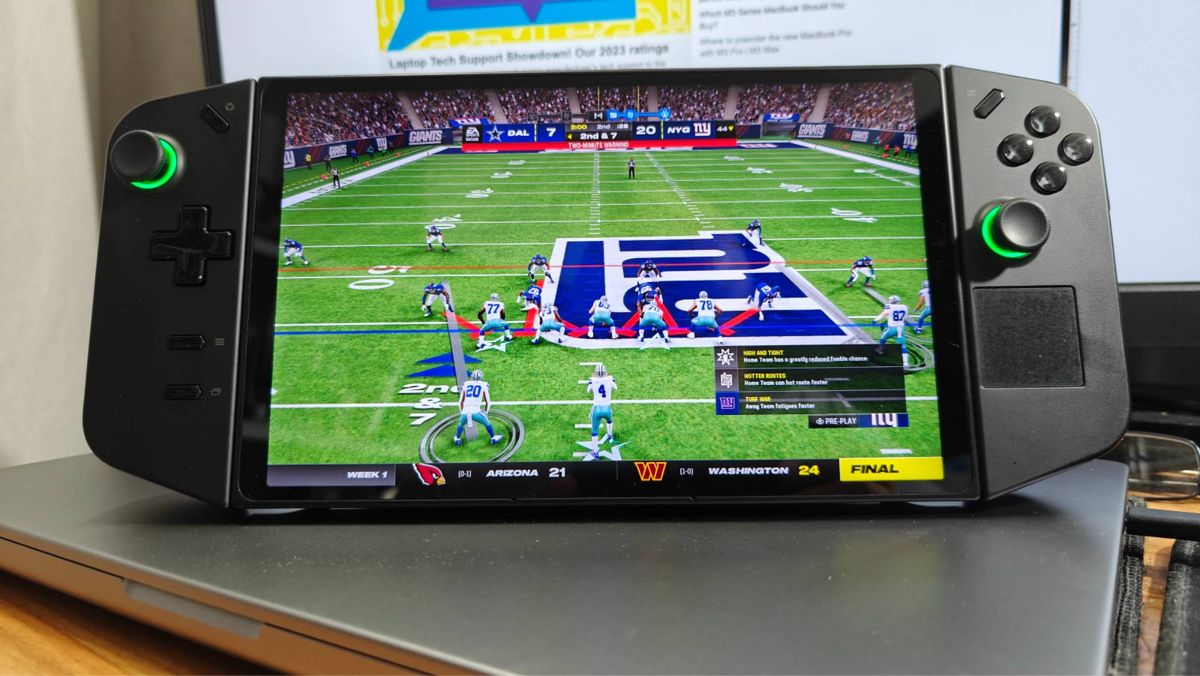

In our comparison, we have a head start on Apple, as the test of the iPhone 15 Pro Max has long since been completed. In the hands-on with the Samsung Galaxy S24 Ultra, on the other hand, we have only been able to give you and ourselves a first impression so far. In this article, we will therefore mainly focus on the technical data and confirmed features – but logically, nextpit will update this article in a few days as soon as the Galaxy S24 Ultra has also been tested in detail.
Samsung Galaxy S24 Ultra vs. iPhone 15 Pro Max: Specifications
Samsung FlagshipGalaxy S24 Ultra
Apple FlagshipiPhone 15 Pro Max
Picture
Review
Not yet tested
Galaxy S24 Ultra hands-on
Review: Apple iPhone 15 Pro Max
Price (MSRP)
Display
6,8-inch LTPO OLED3088 x 1440 px (505 PPI)1-120 Hz refresh rate
6,7-inch OLED2.796 x 1.290 px (460 PPI)120 Hz
SoC
Qualcomm Snapdragon 8 Gen 3
Memory
12 GB LPDDR5X RAM256 / 512 / 1024 GB UFS 4.0 storage
8 GB RAM256 / 512 / 1024 GB storage
Speicher
One UI 6.1 over Android 147 Android upgrades7 years of security updates
Camera
Main: 200 MP, f/1.7, OISUltra-wide: 12 MP, f/2.25x telephoto: 50 MP, f/3.4, OIS3x telephoto: 10 MP, f/2.4, OIS
Main: 48 MP, f/1.78, OISUltra-wide: 12 MP, f/2.25x telephoto: 12 MP, f/2.8
Selfie
Battery
5000 mAh45 W wired charging15 W wireless charging4.5 W reverse wireless charging
4441 mAh20 W wired charging15 W wireless charging (MagSafe)7,5 W wireless charging (Qi)
Connectivity
5G | eSIM | Wi-Fi 7 | Bluetooth 5.3 | NFC | UWB
5G | eSIM | Wi-Fi 6E | Bluetooth 5.3 | NFC | UWB | Satellite
IP certification
Dimensions and weight
162,3 x 79,0 x 8,6 mm, 232 g
159,9 x 76,7 x 8,25 mm, 221 g
Deals*
Table of contents:
Design and display
The Galaxy S class and the iPhone—we already know from many years back that we are dealing with high-quality materials and design. Unsurprisingly, this is also the case in the duel between the iPhone 15 Pro Max and the brand new Galaxy S24 Ultra.
The Samsung Galaxy S24 Ultra looks classy. / © nextpit
In September 2023, the iPhone 15 Pro Max finally ditched the Lightning port in favor of the USB type-C port. Of course, we have been seeing this on Samsung’s smartphones for many years. The situation is reversed when it comes to the choice of titanium material: Apple led the way last year and Samsung has now followed suit, giving the S24 Ultra a titanium frame exclusively in the S24 series.
The iPhone uses a ceramic shield front and matte glass at the back. You can choose between the four colors White Titanium, Black Titanium, Blue Titanium and Nature Titanium.
It’s probably a complete coincidence that Samsung has also opted for color variants with the word “Titanium” in their name: Titanium Black, Titanium Gray, Titanium Violet and Titanium Yellow. You can also get the colors Jade Green, Sandstone Orange and Sapphire Blue exclusively in Samsung’s online store. The Galaxy S24 Ultra relies on Corning Gorilla Glass Armor at the front and back.
The titanium blue color of the iPhone 15 Pro Max is beautiful. / © nextpit
The camera design of both models is based on the respective predecessors. This means that the iPhone 15 Pro Max has a camera island at the top left, which houses the three sensors, while the cameras of the Galaxy S24 Ultra continue to protrude separately from the back. Both models are still IP68-certified and therefore protected against dust and water ingress.
Despite all these similarities, there are also a few features that you won’t find on the respective competitor. On the iPhone, this is the new action button, which is located on the left-hand side and replaces the mute button. Samsung’s unique selling point can be found at the bottom, where the S Pen, Samsung’s iconic smart stylus, is recessed in a slot.
If we look at the displays, in both cases we are dealing with exceptionally good and exceptionally bright OLED displays, which each refreshes images at a rate of 1-120 Hz. Samsung is more variable with the latter feature, as you cannot manually adjust the rate on the iPhone 15 Pro Max.
Samsung’s 6.8-inch flagship has a resolution of 3,120 x 1,440 px, while the 15 Pro Max has a screen diagonal of 6.7 inches and a resolution of 2,796 x 1,290 px. Samsung is therefore slightly ahead in terms of pixel density (505 DPI vs. 460 DPI).
Performance and connectivity
Samsung’s SoC strategy is a bit of a lurch, but at least in the top model we find the best that Qualcomm currently has to offer: The Snapdragon 8 Gen 3, here in the modified “for Galaxy” version. The prime core Cortex-X4 of the SoC, which is manufactured using the 4 nm process, clocks at up to 3.3 GHz. There are also five Cortex-A720 cores and two Cortex-A520 cores for efficiency tasks.
In contrast, the iPhone 15 Pro Max features Apple’s own A17 Pro, also manufactured by TSMC, which is produced using the 3 nm process and whose six cores clock at up to 3.78 GHz. A real powerhouse whose performance ran circles around the competition’s SoCs when it was released last year.
The benchmark test comparison below is still wonderfully meaningless at this point. So far, we have only been able to carry out a quick benchmark test with the S24 Ultra—and with firmware that is not yet final. Of course, you can already take a quick look at the table, but it will only be meaningful after our extensive testing of Samsung’s flagship. The “3DMark Wild Life Extreme” stress test is at least a first indication of how the Snapdragon 8 Gen 3 performs compared to the Apple SoC, but see for yourself:
Samsung Galaxy S24 Ultra(Snapdragon 8 Gen 3 for Galaxy,firmware not final)
Apple iPhone 15 Pro Max(Apple A17 Pro)
3DMark Wild Life Stress Test
Best loop: 9991
Worst loop: 8709
3DMark Wild Life Extreme Stress Test
Best loop: 4,478
Worst loop: 2,816
Best loop: 3,542
Worst loop: 2,405
Geekbench 6
When it comes to RAM—12 GB RAM vs. 8 GB RAM in the iPhone—on paper it may look like a win for Samsung. But bear in mind that it has never been particularly clever to try and slag off Apple’s performance on the basis of bare figures alone. With the non-expandable memory in both cases, you have the choice of whether 256 GB is enough for you or whether you opt for the larger models with 512 GB or 1 TB.
In terms of connectivity, Samsung shines with Wi-Fi 7 support (Wi-Fi 6E on the 15 Pro Max), the rest is largely identical and includes support for eSIM, 5G, NFC and Bluetooth 5.3 as well as UWB. In an emergency, Apple lets you use the “SOS via Satellite” emergency call function on its iPhones, whereas Samsung does not talk to satellites.
Camera
In our last nextpit camera blind test, the iPhone 15 Pro Max only came fourth after the 44,000 votes were evaluated, behind the Galaxy S23 Ultra, among others. But you shouldn’t let this confuse you. Antoine rated the cams of the iPhone 15 Pro Max as very versatile and emphasized the portrait qualities as well as the telephoto zoom.
The triple camera module of the iPhone 15 Pro Max is very versatile. / © nextpit
Apple’s triple-cam array consists of a main camera with 48 MP (f/1.78), an ultra-wide-angle camera with 12 MP (f/2.2) and finally a telephoto lens with 12 MP (f/2.8), which has a 5x optical zoom. The selfie camera at the heart of the “Dynamic Island” offers a resolution of 12 MP.
Sample photos of the iPhone 15 Pro Max:
Ultra-wide angle camera, daylight © nextpit
Main camera (1x), daylight © nextpit
Telephoto camera (2x), daylight © nextpit
Ultra-wide angle camera, daylight © nextpit
Main camera (1x), daylight © nextpit
Telephoto camera (2x), daylight © nextpit
Telephoto camera (5x), daylight © nextpit
Ultra-wide angle camera, daylight © nextpit
Main camera (1x), daylight © nextpit
Telephoto camera (2x), daylight © nextpit
Telephoto camera (5x), daylight © nextpit
Telephoto camera (25x), daylight © nextpit
Ultra-wide angle camera, daylight © nextpit
Main camera (1x), daylight © nextpit
Telephoto camera (2x), daylight © nextpit
Telephoto camera (5x), daylight © nextpit
Telephoto camera (25x), daylight © nextpit
Ultra-wide angle camera, daylight © nextpit
Main camera (1x), daylight © nextpit
Telephoto camera (2x), daylight © nextpit
Telephoto camera (5x), daylight © nextpit
Telephoto camera (25x), daylight © nextpit
Ultra-wide angle camera, daylight © nextpit
Main camera (1x), daylight © nextpit
Telephoto camera (2x), daylight © nextpit
Ultra-wide angle camera, daylight © nextpit
Main camera (1x), daylight © nextpit
Telephoto camera (2x), daylight © nextpit
Telephoto camera (5x), daylight © nextpit
Ultra-wide angle camera, daylight © nextpit
Main camera (1x), daylight © nextpit
Telephoto camera (2x), daylight © nextpit
Telephoto camera (5x), daylight © nextpit
Telephoto camera (25x), daylight © nextpit
Ultra-wide angle camera, Macro Mode, daylight © nextpit
Ultra-wide angle camera, Macro Mode, daylight © nextpit
Ultra-wide angle camera, Macro Mode, daylight © nextpit
Ultra-wide angle camera, Macro Mode, daylight © nextpit
Selfie camera, daylight © nextpit
Selfie camera, Portrait Mode, daylight © nextpit
Selfie camera, night © nextpit
Ultra-wide angle camera, night © nextpit
Main camera (1x), night © nextpit
Telephoto camera (2x), night © nextpit
Telephoto camera (5x), night © nextpit
Ultra-wide angle camera, night © nextpit
Main camera (1x), night © nextpit
Telephoto camera (2x), night © nextpit
Telephoto camera (5x), night © nextpit
Main camera (1x), night © nextpit
Telephoto camera (5x), night © nextpit
Ultra-wide angle camera, night © nextpit
Main camera (1x), night © nextpit
Telephoto camera (2x), night © nextpit
Telephoto camera (5x), night © nextpit
Ultra-wide angle camera, night © nextpit
Main camera (1x), night © nextpit
Telephoto camera (2x), night © nextpit
Telephoto camera (5x), night © nextpit
Samsung has a similar camera setup, but again relies on two telephoto cameras for the Ultra. The Isocell HP2 sensor has already proven itself with its 200 MP in the Galaxy S23 Ultra, but is used here with a new image processor. We are also familiar with the 12 MP ultra-wide-angle sensor from last year’s model. As the 12 MP selfie camera at the front remains the same, we recommend that you take a look at our review of the Galaxy S23 Ultra to find out more about the quality of the cameras.
The Samsung Galaxy S24 Ultra has a powerful 5x zoom camera instead of the 10x zoom camera of the S23 Ultra. / © nextpit
The telephoto cameras, where there has been a change (5x instead of 10x zoom), are exciting. Stefan explains in detail why this is not really a downgrade in the linked article: Is the 5x zoom in the Galaxy S24 Ultra really worse than a 10x zoom? After all, the MP number has been increased to 50 MP for this sensor, while the other telephoto camera with 3x zoom remains at 10 MP.
We can already offer you a few first pictures of the Galaxy S24 Ultra. But of course—as soon as we update this article with the results of our detailed test, this gallery will also become more informative.
Sample photos of the Galaxy S24 Ultra:
Samsung Galaxy S23 Ultra: Test photo of the main camera © nextpit
Samsung Galaxy S24 Ultra: Test photo of the main camera © nextpit
Samsung Galaxy S23 Ultra: Test photo with 3x zoom © nextpit
Samsung Galaxy S24 Ultra: Test photo with 3x zoom © nextpit
Samsung Galaxy S23 Ultra: Test photo with 5x zoom © nextpit
Samsung Galaxy S24 Ultra: Test photo with 5x zoom © nextpit
Samsung Galaxy S23 Ultra: Test photo with 10x zoom © nextpit
Samsung Galaxy S24 Ultra: Test photo with 10x zoom © nextpit
Software
When it comes to software, Apple always benefits from the fact that its own operating system does not have to work for an armada of smartphones from different manufacturers, but only in its own Apple cosmos. As a result, hardware and software are also perfectly coordinated on the iPhone 15 Pro Max with iOS 17.
For many years, Apple’s big plus with software was its long-term support: between five and seven years are always included with your iPhone. Samsung wasn’t bad either with four years of Android updates, but since the Galaxy S24 Ultra, the company has even offered seven years for both Android updates and security patches. However, Apple is still one step ahead: When a new version of the OS is released, all compatible devices can install the update on the same day.
The Galaxy S24 Ultra comes with One UI 6.1, which is based on Android 14. However, the star of the new Ultra model is not the still popular and versatile overlay called One UI, but the new AI platform Galaxy AI.
We have already subjected this Galaxy AI to an initial test, which brings features such as “Circle to Search” to the Galaxy Phone. Similar to Apple, artificial intelligence is increasingly finding its way into Samsung devices, optimizing the camera software and much more.
nextpit has already tested the AI features of the Galaxy AI. / © nextpit
Which software is better? We can’t give a general answer here. Of course, it depends on personal preferences and which ecosystem you are using.
Battery and charging
The battery category is the one where both manufacturers don’t cover themselves in glory. Even in 2024, the 5,000 mAh battery only charges with 45 W at its peak. Wireless charging delivers 15 W and reverse wireless charging still delivers 4.5 W. “That would be nice”, think Apple users, for whom 20 W is already the limit. Those who charge via MagSafe are still happy with 15 W (Qi: 7.5 W). I already mentioned above that wired charging is now possible via USB-C.
Better late than never: Apple finally relies on USB-C. / © nextpit
As both companies also have sustainability in mind, they are saving us unnecessary electronic waste by simply not including chargers in the smartphone packaging. However, according to our test, the battery life of the iPhone 15 Pro Max is very good, so you can get through a full day even with intensive use. As expected, we will have to wait for our review of the S24 Ultra before we can say anything about the battery life of the top-of-the-range phone from South Korea.
Price and availability
While the iPhones in the 15 series went on sale in September 2023, you can only pre-order the Galaxy S24 Ultra as of today. You can find out how to do this in the linked article by Dustin. There you can also find out everything you need to know about the free memory upgrades and other savings options.
If you want to get the best model from Apple or Samsung in 2024, you’ll have to fork out at least €1,449. Both manufacturers are once again in unison when it comes to the minimum price for the 256 GB smartphone. Here are all the prices and available memory variants:
Galaxy S24 Ultra
iPhone 15 Pro Max
256 GB
$1299
$1199
512 GB
$1419
$1399
1 TB
$1659
$1599
Affiliate offer
Affiliate offer
Conclusion
If you’re looking for the best Galaxy phone available, you can’t go past the Galaxy S24 Ultra, and it’s a similar story with Apple and the iPhone 15 Pro Max. However, unlike when we compare different Android models, in this case the other model is often less interesting because you have already made yourself comfortable in one of the ecosystems. So if you work on a Mac and own an Apple Watch, you’re unlikely to opt for an S24 Ultra, even if you think it’s more powerful than the best iPhone.
But the good news is that it doesn’t really matter, because you can’t go wrong regardless of which of the two top smartphones you choose. Both are very expensive, offer identical storage sizes, versatile camera systems with dedicated telephoto sensors and great displays. Both companies support the devices with software for many years, rely on the highest quality materials and workmanship and package it all in a beautiful design.
Apart from that, only the S Pen is really a unique selling point, although I imagine that iPhone fans would defiantly point out that they prefer working with a stylus on an iPad anyway.
Long story short: Whether it’s the Samsung Galaxy S24 Ultra or the iPhone 15 Pro Max, you’ve chosen a very expensive but also exceptional smartphone – congratulations!
Affiliate offer
Affiliate offer






